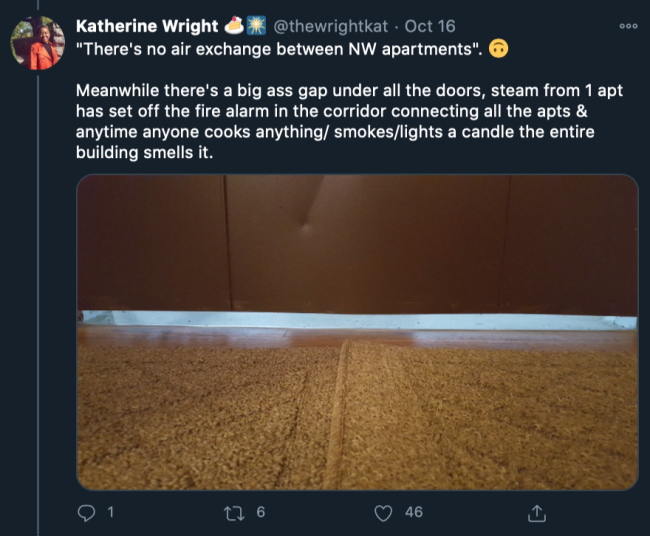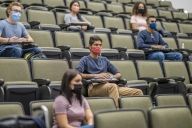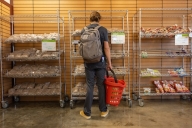You have /5 articles left.
Sign up for a free account or log in.

Faced with a rising COVID-19 case count, the University of Michigan recently began housing quarantined and isolated students in buildings within the Northwood Apartments -- alongside unexposed undergraduate and graduate students.
As one might expect, the idea of living with students who are COVID-19-positive or known to have been exposed didn’t go over well with some of the permanent residents.
“They started moving quarantined and isolated students into the graduate housing, which is occupied by some longtime residents who signed a contract back in March,” prior to the COVID-19 shutdown, said Katherine Wright, a Ph.D. candidate in sociology. “Obviously back then we didn’t know this was part of the reopening plan.”
In an email last month, Michigan notified Northwood residents that it was making good on a previously announced plan to use occupied Northwood buildings as a backup for COVID-19-exposed students, as all vacant buildings used for this purpose were now full.
At the time, quarantine and isolation housing was at nearly 50 percent occupancy. It has since peaked, at 58 percent. In a surprise to residents, the Northwood Apartments were part of the quarantine and isolation inventory all along.
“To help us respond to emergency needs in our community, we will be accommodating students in quarantine or isolation in units within buildings that also house regular term residents,” the email from university housing said. “These additional rooms are part of the university’s overall inventory of quarantine and isolation housing spaces.”
Anticipating residents’ concerns about possible exposure, the email said not to worry, as Northwood apartments “do not have forced air heating and cooling systems” and “there is no air exchange between units.”
The email also set the usual expectations for quarantined and isolated students, including no social gatherings or congregating in public areas, no guests and mandatory wearing of a mask and social distancing when outside the building.
This information didn’t soothe residents like Wright, however.
“Some of the Northwood apartments have an entirely outside exterior, where you don’t share a hallway, and you enter from outside,” she said. “But in others there’s an interior hallway shared by everyone, with a gaps under the doors. In five years of living here, anytime anybody cooks anything, the smell gets past the doors into the apartments. And when you open the door to the apartments in the winter, there’s a draft.”
Wright added, “I’m not an expert in how airflow works, but to say there is no shared airflow is kind of ridiculous to me.”
Wright said she’s complained, including to a campus ombudsman, but she was told that if she’s concerned about people breaking the rules surrounding quarantine, then she should call the police. That in itself is problematic, she said, especially in 2020, for an issue that “frankly, the police shouldn’t be handling.”
Michigan was already on thin ice with its graduate students, who, along with resident advisers, went on strike in September over the university’s COVID-19 response. Many students at the time said that the university’s testing protocol was lax and that it wasn’t taking adequate steps to protect them from infection. The graduate student strike, organized by the American Federation of Teachers-affiliated graduate student union, has since ended. But tensions remain.
According to the union, Michael Zabriskie, senior associate director of university housing, previously said that Michigan had no plans to house quarantined and isolating students in occupied apartment buildings.
“Moving forward, we are not planning on placing students who are in quarantine or isolation due to COVID-related concerns in currently occupied buildings,” Zabriskie wrote in an email to a union member on Sept. 22. “We have a number of completely vacant buildings within Northwood III serving this purpose.”
On Sept. 27, however, the university wrote to students in Northwood, saying, “Since Northwood apartments do not have forced air heating and cooling systems, there is no air exchange between units. As we move forward this fall, we will first use vacant buildings for those students needing quarantine or isolation housing, before using other buildings.”
Apartments identified for quarantine and isolation housing have been assessed by the university’s public health experts and approved for that purpose.
Rick Fitzgerald, university spokesperson, said that housing officials sent an email to residents in September “telling them we would use other buildings for as long as possible. Northwood has always been designated as the location of our [quarantine and isolation] housing.”
Last week, after talking with other Northwood residents, the union wrote to the university, saying that its messaging on housing COVID-19-exposed students within occupied apartment buildings has been contradictory, at best. The union demanded a town hall on the issue, early lease terminations for current residents who want to leave Northwood due to the quarantine issue, trained on-site staff support for quarantining students and notification of RAs when new students move in.
“Residents at Northwood, many of whom are high-risk individuals, are suddenly faced with an impossible situation,” reads the union’s open letter. “As students are sent to Northwood to recover or monitor their symptoms, they’re living in uninhabitable conditions with inadequate nutrition -- far from the ‘hotel experience’ our administration is advertising. These students are also forced to share space with healthy individuals and families, increasingly the likelihood of spread and transmission of COVID-19.”
Current residents “are extremely concerned about the sudden increased likelihood of exposure, and many feel very uncomfortable with the new level of risk. These residents signed leases in the spring without knowing that this would potentially occur.”
Michigan’s quarantine and isolation occupancy rate has fallen, to about 19 percent, since exposed students started moving in to Northwood. With Thanksgiving and the end of fall term coming, quarantine occupancy isn’t likely to be an issue again -- until January.
Craig Roberts, epidemiologist emeritus at the University of Wisconsin at Madison, said moving sick students usually means moving them to a facility "dedicated to only housing other students in isolation and quarantine. Mixing sick and well people together in a shared living space is a problem. Keeping them as physically separate as possible is key."
Michigan's move, therefore, is "not ideal, but probably better than leaving [positive and exposed students] in a conventional residence hall," he said. Common spaces, such as hallways, living areas and lounges, are of primary concern, he said, so "if these are apartments, and they presumably have private bathrooms and kitchens, that's a better arrangement than those with a shared bathroom or kitchen."
"I'm not worried about airflow under the door," he added. "That's a nonissue in my opinion."
Roberts said that to make things "even safer," Michigan could perhaps "designate separate entrances for infected students" and a dedicated unit or floor, where possible.









